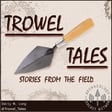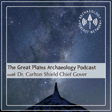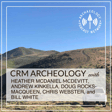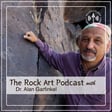Become a Creator today!Start creating today - Share your story with the world!
Start for free
00:00:00
00:00:01

Walking the Line: Survey - Episode 2
Welcome to Trowel Tales! What is Trowel Tales? It’s a story-based podcast with tales told about the exciting, strange, dangerous, and silly things that can happen in the field of archaeology. In this episode, we’ll explore why we walk miles in straight lines looking for artifacts (i.e. survey).
Transcript
Introduction to 'Trial Tales' and Archaeology
00:00:00
Speaker
You are listening to the Archaeology Podcast Network.
00:00:07
Speaker
Hello, and welcome to the second episode of Trial Tales, Stories from the Field. If this is your first time tuning into Trial Tales, you are about to embark on an adventure into the world of archaeology. Last week, we explored what archaeology is all about and how some of us got into this field.
Misconceptions and Realities of Archaeology
00:00:27
Speaker
On this episode, we're going to delve into what archaeologists actually do.
00:00:37
Speaker
After Indiana Jones, the next thing that tends to come to mind about archaeology is digging in the dirt for artifacts. Excavating is a lot of fun, and people love hearing about the different things found on these digs, but it's really just a small part of what we do. For archaeologists that work for federal agencies, like the National Park Service or Forest Service, or those who work for cultural resource management companies, they mostly survey.
00:01:04
Speaker
Don't worry, the next couple of episodes will get into excavation, but for now, you're getting a good dose of survey.
Survey Methods Across Regions
00:01:11
Speaker
So, what does it mean to survey?
00:01:16
Speaker
what survey is depends on what part of the country you're in. If you're in the west, survey is walking across the landscape in a spaced line, evenly spaced, theoretically, line, and looking for stuff, you know, and stopping and recording as you see stuff on the surface. If you're
00:01:43
Speaker
in the east or probably the west coast. I've never worked out there so I don't know. Survey is digging a shovel test, you know, about a 30 to 50 centimeter
00:01:59
Speaker
round hole in the ground, screening that and looking for stuff. So it's, it's all systematic. It's all done on a grid. It's just a matter of how quickly you move, you know, because if you're digging a hole every 15 meters, you're not moving very fast. But if you're walking and looking at the ground, you can cover a lot more acreage that way.
Importance and Dangers of Surveys
00:02:23
Speaker
Why survey important? If you don't look, you don't know what's there.
00:02:30
Speaker
As you can see, survey is all about carefully looking at the landscape for archaeological sites. This helps us know how to best protect these sites for the future. Many a mishap can happen on a survey, from running into rattlesnakes, getting altitude sickness, getting stuck in crazy weather, to running into people with guns. Lots of guns.
00:02:50
Speaker
But then there are the amazing archaeological sites and artifacts that make it all worth it.
Exciting Discoveries: Rare Finds
00:02:56
Speaker
I asked one of my colleagues what was the coolest thing she ever found and recorded on a survey.
00:03:05
Speaker
Probably like most people, it's always really cool to find a projectile point. Those are always fun. One time when I was surveying in California, we were surveying what was called like the beach zone of ancient Lake Cuyah. And it was down by the Mexican border, really sandy, just kind of trudging along. It was pretty hot.
00:03:27
Speaker
But I was walking along and I just kind of saw this piece of green porphyritic metavulcanic rock kind of like sticking out of the sand and I didn't even think it'd be anything but for some reason I decided to pick it up and I picked it up and I'm like, well, what is this? And it was about, I'd say is broken, but it was at least
00:03:47
Speaker
three to four inches long maybe. And it had these really big serrations or barbs. I don't even know what you would call it. And I'm like, this is something. So I called everybody over. I'm like, look at this. Have you ever seen anything like this? And they're like, no. And we had a wonderful Native American monitor working with us.
00:04:08
Speaker
who is from one of the local tribes in Southern California. And he's like, huh, I think I know somebody who might know what this is. So he called that person who's been doing research in the San Diego area. We took points, covered the projectile point up. The person who has been doing the research came and looked at it. And sure enough, it was, I think,
00:04:31
Speaker
They said it was a Descanso point and up until that point they were pretty much only found on the coast in California and they were archaic and they'd never found one that far east. So that was pretty fun. I was like, oh my goodness.
Unusual Finds During Surveys
00:04:45
Speaker
What was the weirdest thing you've ever found on a survey? Oh, you know, like the weird dolls and stuff like that.
00:04:55
Speaker
You know, just like the random trash that ends up, it's nothing archaeological necessarily, but you know, you'll end up with like weird doll heads that have been mutilated or doll bodies. That's always kind of strange. Then you get the drug paraphernalia and pornography that you find out in the middle of the desert sometimes too. That's always a little bit kind of eh.
Encountering Challenges and Dangers
00:05:18
Speaker
You never know what you'll find on a survey or who or what you might run into. So for a period of time, it seemed like
00:05:29
Speaker
Every time I was surveying specifically with one person, we would see large animals or signs of large animals. We'd come across, you know, bear tracks and mountain lion tracks and, you know, see a mountain lion, see some bear cubs, you know, and mama bear. You just never know what you're going to find. And that's not even talking about the rattlesnake switcher.
00:05:57
Speaker
always present, it seems, and only rattle when you're right up upon them.
00:06:06
Speaker
In some ways, that's one of my favorite parts about surveys. You never know what kind of nature you're going to see. If you're going to see, you know, snakes and wildlife and birds and, you know, just being outside all day, you start to notice a lot more about the landscape than you do when you just, you know, drive by it or spend a couple hours outdoors every, you know, few days.
Joy and Unpredictability of Surveys
00:06:35
Speaker
Archaeology is cool. Archaeology is more than just looking for stuff. There's one day where me and my friends were out recording this one site. It was a cliff dwelling. It was me and two other people. And we were in there for a little while and we started hearing some voices down below us, down below the alcove that we're in.
00:07:06
Speaker
And we kept on recording and kept on hearing him getting closer and closer. And finally I started seeing someone coming up the slope into the alcove where I was. And I was the first person that you could see two other people were in rooms that were further down along the cliff dwelling. When he came up the slope, I saw his shoulders were down and
00:07:32
Speaker
He was making it
Overcoming Difficult Survey Conditions
00:07:33
Speaker
pretty quickly towards us, and I could see there was a belt that he had on with a gun, and the belt was lined with bullets. And he didn't look too happy, and he came up to us, started talking to me, saying that he saw our vehicle out in the forest and was wondering where we were. And I was a little nervous.
00:07:59
Speaker
He started talking with me a little bit more and so he brought his family out here and wanted to check out the area. And soon his family started coming up the slope with him. And his family, probably two teenage boys, one pre-teen girl, and then his wife.
00:08:25
Speaker
And the boys all had guns on them. They were all drinking, all smoking, and they were interested in the cliff dwelling and were asking us a lot of questions. But we noticed they started making themselves pretty comfortable in the area as we were talking to them, telling them what we're doing, telling them how important it is to protect these cliff dwellings.
00:08:50
Speaker
We noticed that they started crushing cans, beer cans, on the cliff dwelling and throwing out their cigarettes in the cliff dwelling. And up until that point, it was just myself that was talking to them.
00:09:03
Speaker
My friend came out of the room and started telling them how they shouldn't be crushing the cans on the walls and they shouldn't be throwing out their cigarettes and they need to respect the area. I was very nervous and was telling them, you know, they're drunk. Just let them do what they're doing. They got guns on them. We don't want to make them.
00:09:23
Speaker
angry or anything. I'm noticing during this entire time that the third person that's in the farthest room is saying really quiet. He's not even popping up or talking. Anyway, they started talking about other cliff drawings in the area and at that point we're pretty sure that they were pot hunters. They started talking about all the artifacts that they found and how they've led other family members out there. After they left and after we left for the day,
00:09:51
Speaker
We made sure that they weren't around, but we started talking about what happened. Especially the person that was in the farthest room, you know, why didn't he make any noise? And he mentioned that he didn't want to, he heard what was going on, didn't want to be a part of it. Knew that was something that could go very badly. And we discussed how, yeah, they probably were looking to steal some artifacts from there and to dig some holes in the area.
00:10:20
Speaker
And we're just thankful that nothing happened. We're pretty far out from the nearest town and we're relieved when they finally left.
Preservation Over Collection
00:10:34
Speaker
It was me and one other guy and I was in charge and we just needed to get it done. And it did start raining pretty good, but there wasn't any lightning. So technically it was safe. There was definitely a rainstorm. It was pretty wet. We were soaked. There was the rattlesnake that obviously in the rain it wasn't going to be doing anything. It was just curled up and not moving because, you know, they're not that active when it's that chilly out. And then of course we weren't really finding anything, but then we hit the
00:11:03
Speaker
the can scatter, you know, the historic can scatter and it's like, oh, you got to be kidding me. And it's like, of course, you know, we're sitting there in the rain trying to record this stupid can scatter with a few pieces of historic glass and everything's just crushed and it's kind of spread out and dispersed and we just want to get out of the rain and we're like,
00:11:26
Speaker
good 20-minute walk from where the truck is and it was just kind of miserable, you know. I didn't have any right in the rain gear so I was trying to take notes on my paper while it's getting soaked and it was just nearly impossible and it was so frustrating. It's like, yeah, nothing prehistoric. We're almost done. We're heading back to finish off our transect going back to the truck when we hit the cans, you know.
00:11:57
Speaker
The first survey I ever did completely alone was out in the wilderness and I had to backpack at least 16 miles over a mountain pass through streams down into a canyon just to get to the actual survey location.
00:12:13
Speaker
Excited and terrified all at the same time I've backpacked before and conducted some pretty rough surveys, but this was something completely new for me Changing elevation by 2,000 feet at least twice in one day and again all on my own and really far away from any kind of contact outside of a radio and
00:12:39
Speaker
On the way, I managed to fall down a switchback and get banged up. I nearly stepped on a rattlesnake. I got altitude sickness and heat exhaustion all at the same time. And my feet were an absolute blistered mess.
00:12:55
Speaker
Now, 16 miles doesn't sound like very much, but when you're doing up and down and over mountain passes and through all this kind of stuff, it roughed me up pretty well. So by the time I actually reached my survey corridor, I was in relatively rough shape. But I got the survey done.
00:13:17
Speaker
So that's a positive. I wish I could say I found some epic site or really amazing artifacts, but all I found was a couple of obsidian flake scatters, maybe, you know, a couple flakes here and there. I guess the survey in itself was epic enough. Besides, I was going to have to do it all again just to another remote location and just another couple of weeks. All in a day's work.
00:13:48
Speaker
That's it for today's podcast. I hope you enjoyed learning a little bit about how and why we survey the landscape for cultural remains. I have to jump on my soapbox for just a second. We just record the artifacts we see on a survey. We don't take anything with us. So if you're out on a hike and you find historic tin cans or an arrowhead, you can look at the artifacts, you can take a picture, but
00:14:15
Speaker
Always, always put those artifacts back. Okay, soapbox done.
Engaging the Audience and Future Topics
00:14:21
Speaker
On the next episode... The bottom of one of the burial pits was a almost perfectly intact tripod vessel. And then underneath that was a conch shell that was carved into a pendant with a bird head.
00:14:40
Speaker
I was excavating through an old looter's pit and extremely hard dirt, so I was hacking away with my trowel. All of a sudden my trowel hit something hard, making this really loud clang. I had just hit a Roman statue head. Luckily I didn't leave. We'll explore the world of excavation.
00:15:03
Speaker
Special thanks to Carrie, Sarah, and Matt for sharing their stories on the podcast. Check us out on Facebook to learn more about the podcast and let us know what kind of stories you'd like to hear. Also, if you're an archaeologist and would like to contribute a tale or two, send a message.
Acknowledgments and Audience Engagement
00:15:22
Speaker
And don't forget to check out all of the wonderful podcasts available on the Archaeology Podcast Network. Until next time,
00:15:31
Speaker
This episode was produced by Chris Webster and Tristan Boyle and was beautifully edited by Emily Long. This has been a presentation of the Archaeology Podcast Network. Visit us on the web for show notes and other podcasts at www.archaeologypodcastnetwork.com Contact us at chrisatarchaeologypodcastnetwork.com








